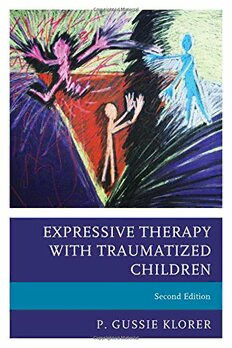
Expressive Therapy with Traumatized Children PDF
Preview Expressive Therapy with Traumatized Children
Expressive Therapy with Traumatized Children Expressive Therapy with Traumatized Children Second Edition P. Gussie Klorer Southern Illinois University Edwardsville ROWMAN & LITTLEFIELD Lanham • Boulder • New York • London Associate Editor: Molly White Senior Marketing Manager: Karin Cholak Cover Artist: P. Gussie Klorer Credits and acknowledgments for material borrowed from other sources, and reproduced with permission, appear on the appropriate page within the text. Published by Rowman & Littlefield A wholly owned subsidiary of The Rowman & Littlefield Publishing Group, Inc. 4501 Forbes Boulevard, Suite 200, Lanham, Maryland 20706 www.rowman.com Unit A, Whitacre Mews, 26–34 Stannary Street, London SE11 4AB, United Kingdom Copyright © 2017 by Rowman & Littlefield First edition 2000. All rights reserved. No part of this book may be reproduced in any form or by any electronic or mechanical means, including information storage and retrieval systems, without written permission from the publisher, except by a reviewer who may quote passages in a review. British Library Cataloguing in Publication Information Available Library of Congress Cataloging-in-Publication Data Names: Klorer, P. Gussie, author. Title: Expressive therapy with traumatized children/P. Gussie Klorer, Southern Illinois University Edwardsville. Other titles: Expressive therapy with troubled children Description: Second edition. | Lanham : Rowman & Littlefield, [2017] | Revision of: Expressive therapy with troubled children. 2000. | Includes bibliographical references and index. Identifiers: LCCN 2016048441 (print) | LCCN 2016048995 (ebook) | ISBN 9781442268555 (cloth : alk. paper) | ISBN 9781442268562 (pbk. : alk. paper) | ISBN 9781442268579 (electronic) Subjects: LCSH: Art therapy for children. Classification: LCC RJ505.A7 K56 2017 (print) | LCC RJ505.A7 (ebook) | DDC 618.92/891656—dc23 LC record available at https://lccn.loc.gov/2016048441 ™ The paper used in this publication meets the minimum requirements of American National Standard for Information Sciences—Permanence of Paper for Printed Library Materials, ANSI/NISO Z39.48–1992. Printed in the United States of America To all of the children who taught me how to be a therapist Contents Preface ix Acknowledgments xiii Chapter 1 Trauma Treatment for Children 1 Chapter 2 The Neuroscience of Art Therapy and Trauma 9 Chapter 3 Setting the Stage for Expressive Work 17 Chapter 4 “Daddy Beat My Sister, Not Me”: Trusting the Art More Than the Words 41 Chapter 5 The Preverbal Child, Ages 0 to 2 55 Chapter 6 The Early School-Aged Child, Ages 2 to 7 71 Chapter 7 The Middle Years, Ages 7 to 12 87 Chapter 8 Ages 12 through Adolescence 101 Chapter 9 “My Heart Bleeds for Harmony”: Involving the Family in Therapy 115 Chapter 10 “I’ll Live with My Mom When She Gets Her Life Together”: Tammy’s Story 141 Chapter 11 “Art Has Truth”: John’s Story 153 Chapter 12 “A Hope Rainbow”: Ebony’s Story 161 vii viii • Contents Chapter 13 “Stories to Teach about My Mom”: Julie’s Story 171 Chapter 14 The Therapist’s Container 181 Chapter 15 Putting the Puzzle Together 193 References 195 Index 209 About the Author 213 Preface The rainbow is God’s promise Of hope for you and me And though the clouds hang heavy And the sun we cannot see We know above the dark clouds That fill the stormy sky A Hope Rainbow will come shining through When clouds have drifted by. —Ebony, age 13 When contemplating a second edition for Expressive Therapy with Troubled Children, my first thought was: How did almost 20 years pass since I began the initial research for the book? Readers familiar with the work will imme- diately notice that this second edition includes a title change, from Expres- sive Therapy with Troubled Children to Expressive Therapy with Traumatized Children. The latter was actually the original title to the book, but back in the late 1990s the publisher was reluctant to put out a book with “trauma” in the title and suggested something more generic. Of course, the 2000s then saw a surge in books with “trauma” in the title, so I like to believe that this book was just ahead of its time. Since its first printing, our understanding of the neuroscience of trauma and art therapy has exploded. We not only have a better understanding of how trauma affects the developing brain but also have a much clearer idea of why the expressive therapies are so effective in trauma treatment. ix
